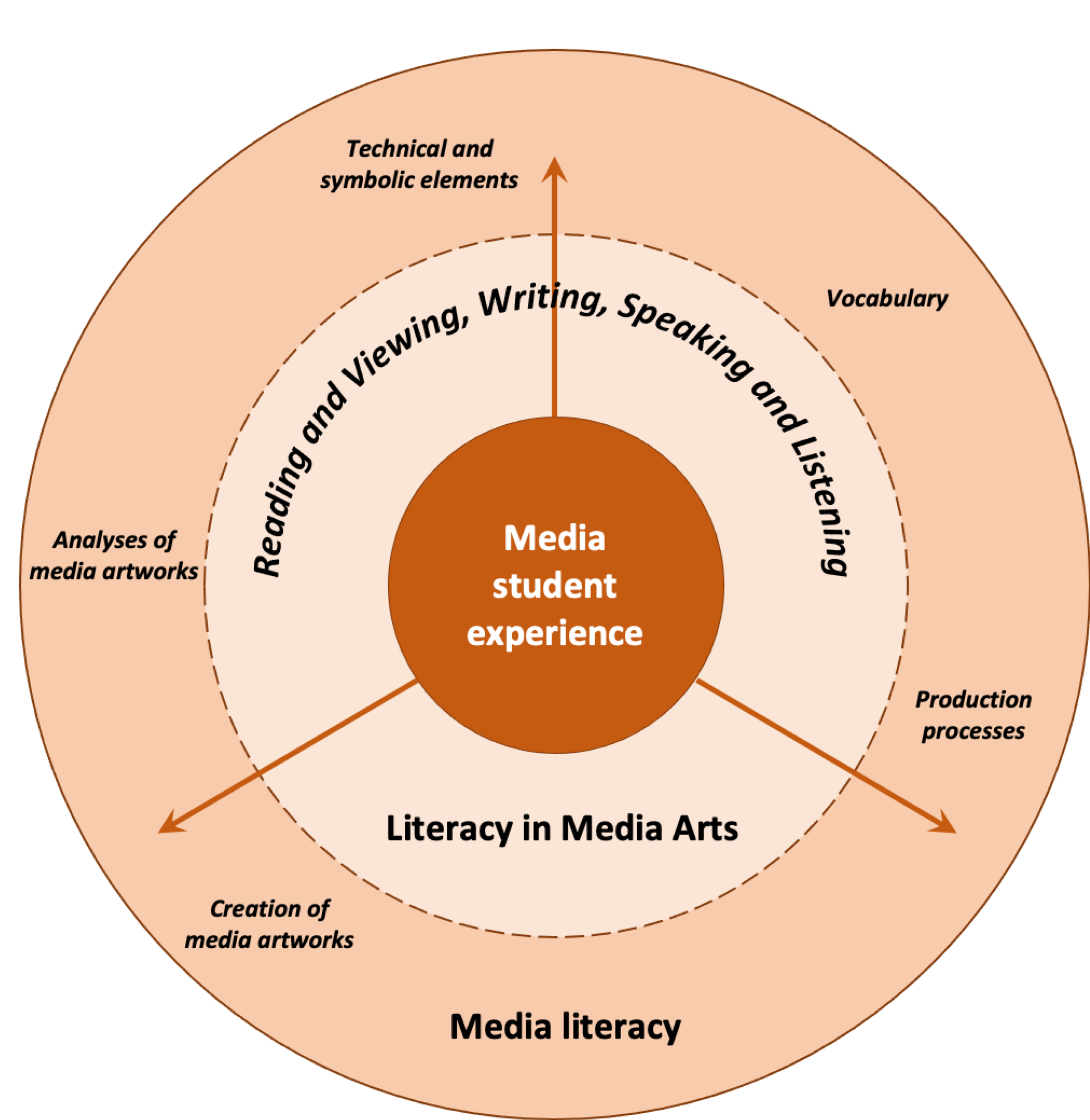This section is focused on literacy in Media Arts.
The information and resources address the reading and viewing, writing, and creating, and speaking and listening modes across the Media Arts curriculum.
Literacy in Media Arts
Literacy in Media Arts helps students to develop their understanding of media concepts and enhances their ability to create media-based artwork. For students to develop media literacy, they must engage in literate practices to develop their understanding of Media Arts concepts.
Literacy in Media Arts:
- refers to the literate practices and strategies that enable students to understand, synthesise and communicate Media Arts content knowledge
- relates to the reading, viewing, writing, speaking, and listening practices that students use to understand, interpret, and communicate Media Arts knowledge.
Media literacy, on the other hand, refers to:
- student understanding of Media Arts vocabulary, concepts, processes, and their ability to apply this knowledge to their own experiences and creative artworks (Buckingham, 2013).
The development of literacy skills in Media Arts is different from the development of media literacy, although both are necessary for the subject and one cannot be achieved without the other.

Literate demands in Media Arts education
In Media Arts, students investigate how societies communicate and create meaning through the design of visual representations and stories. To do this, students:
- analyse existing media artworks
- create new media artworks in response to existing artworks.
The literate demands towards reading and viewing, writing, speaking, and listening within Media Arts are multifaceted and complex (Rasi, Vuojärvi, & Ruokamo, 2019). This is because media artworks are inherently multimodal, including written, visual, symbolic, and aural language.
To interpret and create media artworks, students must develop their understanding of
- how meaning is encoded through individual modes of communication, including visual, aural, written, and symbolic language
- how meaning is constructed in multimodal texts through the interrelationship of the various modes of communication.
In Media Arts, students also need to develop a broad vocabulary to communicate effectively. Media Arts terminology is informed by the vocabulary and communication practices of professional media industries (Ascher & Pincus, 2007). Media Arts terminology can be thought of in two ways:
- as a means of discussion, i.e. the terminology students use to analyse the construction of meaning in existing media artworks
- as a framework for construction, i.e. the terminology students use in the design, development, production, and distribution of the media artworks they create.
Once students have developed their vocabulary to talk about and analyse media artworks, they need to be able to create a range of genres and text types, including:
- informative texts, such as procedures, reports, and explanations
- persuasive texts, such as expositions and discussions, as well as responses to media artworks (ACARA, n.d.).
Literacy in the Victorian Curriculum: Media Arts
Literate practices are embedded in the rationale and aims of the Victorian Curriculum: Media Arts.
For example, the curriculum aims to ensure students:
- create visual representations that communicate, challenge, and express their own and others' ideas, as both artist and audience
- develop their perceptual and conceptual understandings, critical reasoning, and practical skills
- develop critical and creative thinking skills, Media Arts languages, knowledge of Media Arts theories and practices (VCAA, n.d.)
The Media Arts curriculum is structured around four strands. Within each strand, students must develop distinct literate practices to make and respond to media artworks. Students undertake reading and viewing, writing, and speaking and listening to:
- explore, experiment with, and communicate ideas
- manipulate the structure, elements, concepts, and intent within Media artworks
- develop an understanding of skills, techniques, technologies, and processes as Media Arts practice
- plan, produce, present, and distribute Media artworks
- analyse, evaluate, interpret, and reflect upon Media artworks (VCAA, n.d.).
Students in Media Arts develop their knowledge and understanding in five key areas:
- media languages
- media technologies
- institutions that produce Media artworks
- audiences
- constructed representations of the world (VCAA, n.d.).
By developing their understanding of how representations are communicated through languages and technologies, and how this differs between target audiences and institutional contexts, students are better able to analyse and create distinct media artworks.
References
Ascher, S., and Pincus, E. (2007). The filmmaker's handbook: A comprehensive guide for the digital age. Penguin.
Buckingham, D. (2013). Media education: Literacy, learning and contemporary culture. John Wiley & Sons.
Rasi, P., Vuojärvi, H., and Ruokamo, H. (2019). Media Literacy Education for All Ages. Journal of Media Literacy Education, 11(2), 1-19.
Victorian Curriculum and Assessment Authority (VCAA) (n.d.) Victorian Curriculum F-10: Media Arts. Retrieved from https://victoriancurriculum.vcaa.vic.edu.au/the-arts/media-arts/introduction/learning-in-media-arts